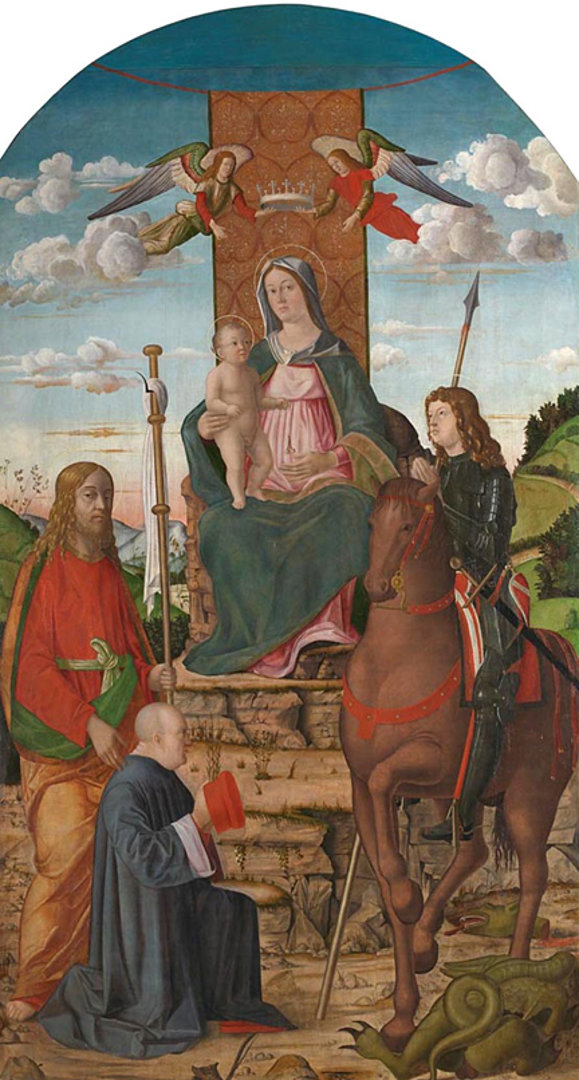Conservation revealed
'The Virgin and Child with Saints' by Giovanni Martini da Udine
Issued August 2019
The Virgin and Child with Saints (probably about 1500–25) is one of the major surviving painted altarpieces by the Italian Renaissance painter and sculptor, Giovanni Martini da Udine (about 1470–1535). Most of his career was spent in Friuli, north of Venice.
The picture was painted on a wooden panel, which is very reactive to changes in humidity and climate. As a result, the altarpiece had already undergone several major structural changes before the Gallery acquired it in 1867.When it entered the collection, the wood was conserved using a technique called cradling, which was the best practice at this time. Although this work was done with the best of intentions, it ultimately made the altarpiece even more fragile.
In 2011, the Gallery decided to conserve the altarpiece to preserve it for future generations – seven years later, this Room 56 display offers a rare opportunity to see how the National Gallery’s conservation studio has approached one of the most intricate structural conservation projects it has ever undertaken.
History of 'The Virgin and Child with Saints'
From studying the panel carefully, conservators discovered how the panel was originally constructed and that the altarpiece originally had an arched top. It was painted on three long, wide, poplar boards that would have been 4–5 cm thick. These boards were glued together and reinforced with butterfly-shaped inserts. Nails were driven in from the front to attach three supporting battens to the back before the wood was prepared for painting.
In the 19th-century the panel was thinned to 5 mm and flattened before a cradle (a lattice of wooden slats) was glued on. Although the cradle supported the panel, it limited any possible changes in size or curvature, which led to splits and distortions.
National Gallery conservation treatment
Firstly, the old varnish and re-paints were removed from the altarpiece, then the cradle was carefully removed using hand tools and the panel was divided into its three component boards.
Glue and old fillings were cleaned from the splits in the three boards. Paint flakes that had been dislodged and stuck in the wrong places during previous treatments were realigned. The hundreds of splits in the wood were levelled using pressure from above and below, then repaired with adhesive.
Severe woodworm damage, which happened before the painting entered the collection, along with wide compound fractures, meant that some of the wood was missing and needed to be built up.
When the damages were all repaired, and the three boards were rejoined, the thinned and weakened panel needed a reinforcing structure to keep it stable, so we designed an auxiliary support. This had to be flexible, so that the wood could continue to move and shrink without causing further cracks in the paint layer.
In order to suggest the original format of the painting, an arched addition now sits on top of the panel: it is not glued in place, but is attached to the auxiliary support.
Finally, the losses to the paint were filled and retouched, and the panel was framed to ensure it could still move if it needed to.
The cleaning, structural repair and restoration treatment of 'The Virgin and Child with Saints' was led by National Gallery Conservator Britta New with other members of the Conservation Department. Britta said,
'Although cleaning and restoration of this altarpiece had many challenges, the structural work in particular was incredibly complex. We had to use all the skills at our disposal and learn new ones too. We are very lucky because not many conservation studios are able to take on treatments like this and the Martini provided great opportunities to further our experience in working on panel paintings - it has really informed the structural treatments we have carried out since.'
Caroline Campbell, Director of Collections and Research said'
'The National Gallery is one of just a handful of institutions across the world that is able to carry out painting conservation treatments of this complexity. As this work has been carried out behind closed doors, this display is an opportunity to share this expertise with the public and also to celebrate our conservation skills, in a similar way to how we shared the conservation of our Artemisia Gentileschi self portrait via a series of films.' She added, 'We would like to acknowledge the Getty Foundation – the establishment of their Panel Painting Initiative in 2009 has hugely boosted the field and has encouraged inter-generational and inter-national sharing of expertise and the joint development of skills.'
For more information, visit nationalgallery.org.uk
NOTES TO EDITORS
ABOUT THE PAINTING
The Apostle James the Greater looks directly out at us, drawing us into the rocky terrain. His hand touches the shoulder of a kneeling man - most likely the patron who commissioned the work. Using infrared, we can see the underdrawings which reveal how the artist experimented with the position of the patron’s head and body.
At the far right we see a knight on horseback, Saint George, who was believed to have rescued a young woman from a dragon. The dragon’s headless body lies on the ground. Saint George prays to the Christ Child who stands on the Virgin Mary’s knee and is the focus of this altarpiece. This type of painting, called a 'sacra conversazione' (holy conversation) between the Virgin, Christ Child and saints became increasingly popular over the course of the 15th century.
IMAGE
Giovanni Martini da Udine
'The Virgin and Child with Saints George, James the Greater and a Donor'
Short title: 'The Virgin and Child with Saints'
Probably about 1500–25
Oil on wood 247.7 x 144.8 cm
Bought, 1867
© The National Gallery, London
PRESS ENQUIRIES
National Gallery Press Office on 020 7747 2865 or email press@ng-london.org.uk
Publicity images can be obtained from https://press.nationalgallery.org.uk/

